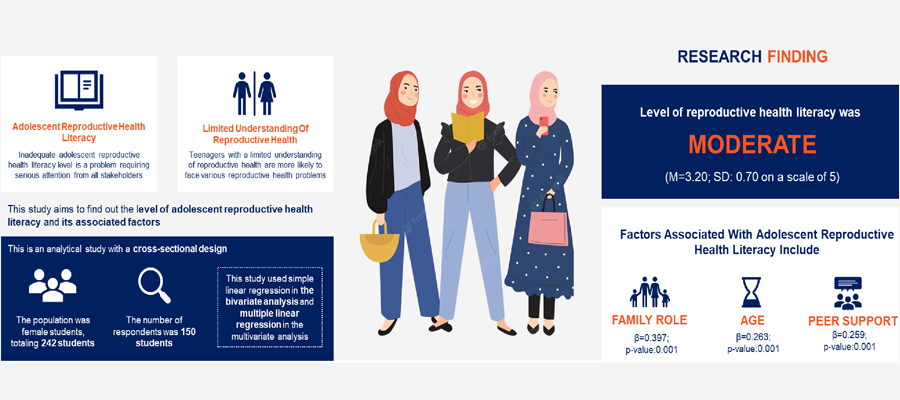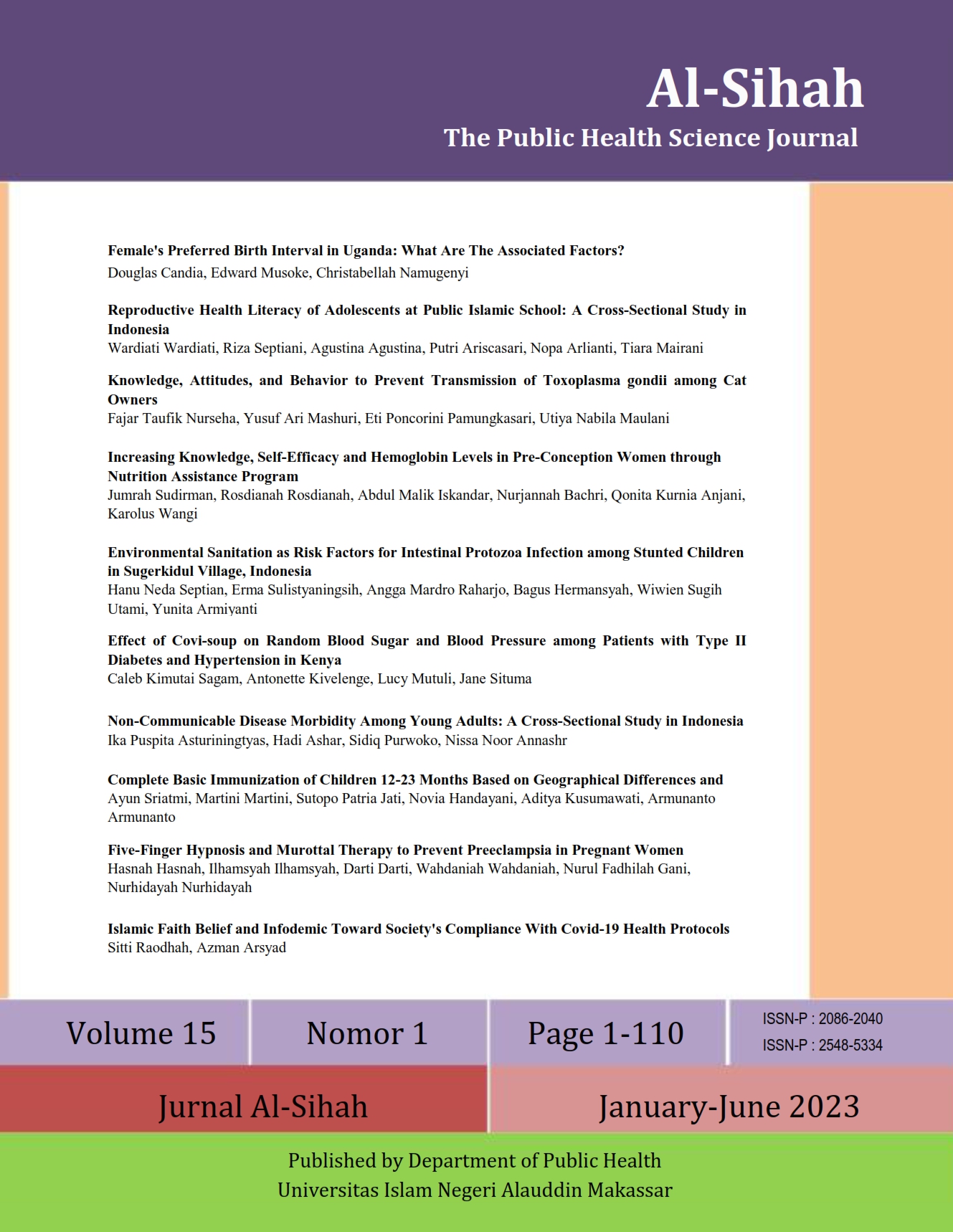Reproductive Health Literacy of Adolescents at Public Islamic School: A Cross-Sectional Study in Indonesia
Abstract
Inadequate adolescents’ reproductive health literacy is a serious problem that requires urgent attention from all stakeholders. Adolescents with limited knowledge of reproductive health are more prone to facing various health problems. Therefore, this study aims to determine the level of adolescents reproductive health literacy and its associated factors. An analytical approach was adopted with a cross-sectional design. The target population consisted of female students in classes XI and XII, at Public Islamic Senior High School 2 Banda Aceh, totaling 242 students. An accidental sampling method was utilized to select the sample, and the number of respondents was 150 students. The data obtained were analyzed using simple linear and multiple linear regression tests. The results showed that the level of reproductive health literacy was moderate (M=3.20; SD: 0.70 on a scale of 5), while the associated factors included family role (β=0.397; p-value:0.001), age (β=0.263; p-value:0.001), and peer support (β=0.259; p-value:0.001). These variables accounted for 43.4% of the variance in adolescents reproductive health literacy (R2:0.434). Based on the results, it was concluded that the level of adolescents reproductive health literacy was insufficient, and factors correlated to this problem included family role, age, and peer support.

Downloads
References
Abdallah, A. K., Magata, R. J., & Sylvester, J. N. (2017). Barriers to parent-child communication on sexual and reproductive health issues in East Africa: A review of qualitative research in four countries. Journal of African Studies and Development, 9(4), 45–50. https://doi.org/10.5897/jasd2016.0410
Alzate, M. M., Dongarwar, D., Matas, J. L., & Salihu, H. M. (2020). The Effect of Sexual Literacy on Adolescent Pregnancy in Colombia. Journal of Pediatric and Adolescent Gynecology, 33(1), 72–82. https://doi.org/10.1016/j.jpag.2019.09.005
Amrullah. (2014). Fenomena Sosial Jarimah Khalwat Dan Sex Bebas Di Kota Banda Aceh Setelah Pemberlakuan Qanun No. 6 Tahun 2014 Tentang Hukum Jinayat. Al-Ijtima’ i International Journal of Government and Social Science, 6(1), 99–113.
Arifah, I., Safari, A. L. D., & Fieryanjodi, D. (2022). Health Literacy and Utilization of Reproductive Health Services Among High School Students. Jurnal Promosi Kesehatan Indonesia, 17(2), 79–85. https://doi.org/10.14710/jpki.17.2.79-85
Astuti, Andari, W., Hirst, J., & Bharj, K. K. (2020). Indonesian adolescents’ experiences during pregnancy and early parenthood: a qualitative study. Journal of Psychosomatic Obstetrics & Gynecology, 41(4), 317–326. https://doi.org/10.1080/0167482X.2019.1693538
Astuti, W., Muna, Z., & Julistia, R. (2021). Gambaran Kontrol Diri Pada Siswa SMP Kota Lhokseumawe Dalam Mencegah Perilaku Seksual Pranikah. Jurnal Diversita, 7(1), 72–78. https://doi.org/10.31289/diversita.v7i1.4526
Bashir, Q., Usman, A., Amjad, A., & Amjad, U. (2017). The Taboo that Silences’: Awareness about Sexual and Reproductive Health Issues among Adolescent Females during Pubertal Transition. Isra Medical Journal, 9(6), 381–385.
Bronfenbrenner, U. (1989). The Bioecological Model of Human Development. In Annals of Child Development: Revised Formulations and Current Issues (6th ed., pp. 793–828). JAI Press.
Brown, B. B., & Anistranski, J. A. (2020). Peer Influence in Adolescence. In The Encyclopedia of Child and Adolescent Development (pp. 1–11). https://doi.org/10.1002/9781119171492.wecad398
Dabiri, F., Hajian, S., Ebadi, A., Zayeri, F., & Abedini, S. (2019). Sexual and reproductive health literacy of the youth in Bandar Abbas. AIMS Medical Science, 6(4), 318–325. https://doi.org/10.3934/medsci.2019.4.318
Dongarwar, D., & Salihu, H. M. (2019). Influence of Sexual and Reproductive Health Literacy on Single and Recurrent Adolescent Pregnancy in Latin America. Journal of Pediatric and Adolescent Gynecology, 32(5), 506–513. https://doi.org/10.1016/j.jpag.2019.06.003
Effendi, Handayani (deceased), Nugroho, & Hariastuti. (2021). Adolescent pregnancy prevention in rural Indonesia: a participatory action research. Rural and Remote Health, 21(3), 1–12. https://doi.org/10.22605/RRH6639
Fatimah, J. M., Arianto, & Bahfiarti, T. (2021). Media communication and youth reproductive health, North Toraja District. Gaceta Sanitaria, 35(S2), S112–S115. https://doi.org/10.1016/j.gaceta.2021.07.007
França, A. S., Pirkle, C. M., Sentell, T., Velez, M. P., Domingues, M. R., Bassani, D. G., & Câmara, S. M. A. (2020). Evaluating health literacy among adolescent and young adult pregnant women from a low-income area of northeast brazil. International Journal of Environmental Research and Public Health, 17(23), 1–15. https://doi.org/10.3390/ijerph17238806
Ghanbari, S., Ramezankhani, A., Montazeri, A., & Mehrabi, Y. (2016). Health Literacy Measure for Adolescents (HELMA): Development and Psychometric Properties. PLOS ONE, 11(2), e0149202. https://doi.org/10.1371/journal.pone.0149202
Guan, M. (2021). Sexual and reproductive health knowledge, sexual attitudes, and sexual behaviour of university students: Findings of a Beijing-Based Survey in 2010-2011. Archives of Public Health, 79(1), 1–17. https://doi.org/10.1186/s13690-021-00739-5
Hamzah, S. R. ah, Ismail, M., & Mohd Nor, Z. (2018). Does attachment to parents and peers influence health literacy among adolescents in Malaysia? Kontakt, 20(4), e348–e355. https://doi.org/10.1016/j.kontakt.2018.10.006
Ibegbulam, I. J., Akpom, C. C., Enem, F. N., & Onyam, D. I. (2018). Use of the Internet as a source for reproductive health information seeking among adolescent girls in secondary schools in Enugu, Nigeria. Health Information & Libraries Journal, 35(4), 298–308. https://doi.org/10.1111/hir.12242
Joseph, N., Mahato, V., Pandey, A., Mishra, S., Prakash, G., & Gandhi, R. (2021). Experiences and perception towards reproductive health education among secondary school teachers in South India. Reproductive Health, 18(175), 1–10. https://doi.org/10.1186/s12978-021-01224-6
Juariah, J., & Irianto, J. I. (2020). Peran Dan Faktor Yang Berhubungan Dengan Perilaku Guru Dalam Pendidikan Kesehatan Reproduksi Remaja Sekolah Menengah Pertama Di Kabupaten Subang Tahun 2019. Jurnal Kesehatan Reproduksi, 11(1), 11–24. https://doi.org/10.22435/kespro.v11i1.3092
Kanellopoulou, A., Notara, V., & Panagiotakos, D. B. (2022). The role of family structure in health literacy in children and adolescents: a narrative review. Global Health Promotion, 17579759221091210. https://doi.org/10.1177/17579759221091210
Khairunnisa, Wardiati, & Agustina. (2023). Literasi Kesehatan Reproduksi Remaja dan Faktor-Faktor yang Mempengaruhinya (Sebuah Penelitian Cross-Sectional pada Siswi Madrasah Aliyah Negeri 1 Banda Aceh). Media Publikasi Promosi Kesehatan Indonesia (MPPKI), 6(6), 1142–1149. https://doi.org/10.56338/mppki.v6i6.3398
Kistiana, S., Fajarningtiyas, D. N., & Lukman, S. (2023). Differentials in Reproductive Health Knowledge among Adolescents in Indonesia. Media Kesehatan Masyarakat Indonesia, 19(1), 19–29. https://doi.org/10.30597/mkmi.v19i1.23641
Kyilleh, J. M., Tabong, P. T. N., & Konlaan, B. B. (2018). Adolescents’ reproductive health knowledge, choices and factors affecting reproductive health choices: A qualitative study in the West Gonja District in Northern region, Ghana. BMC International Health and Human Rights, 18(1), 1–12. https://doi.org/10.1186/s12914-018-0147-5
Lakhmudien, Soedirham, O., & Fatah, M. Z. (2019). Reproductive Health Literacy Level of Adolescents in Senior High School in Semarang City. International Journal of Public Health and Clinical Sciences, 6(1), 75–85. https://doi.org/10.32827/ijphcs.6.1.75
Ma, X., Yang, Y., Wei, Q., Jiang, H., & Shi, H. (2021). Development and validation of the reproductive health literacy questionnaire for Chinese unmarried youth. Reproductive Health, 18(1), 226. https://doi.org/10.1186/s12978-021-01278-6
Maesaroh, M. (2020). Pengaruh Peran Tenaga Kesehatan Tehadap Pencegahan Penyakit Menular Seksual. Jurnal Kesehatan, 11(2), 93–102. https://doi.org/10.38165/jk.v11i2.208
Maina, B. W., Ushie, B. A., & Kabiru, C. W. (2020). Parent-child sexual and reproductive health communication among very young adolescents in Korogocho informal settlement in Nairobi, Kenya. Reproductive Health, 17(1), 1–14. https://doi.org/10.1186/s12978-020-00938-3
Ministry of Health of Indonesia. (2018). Indonesia Demographic and Health Survey 2017.
Mollborn, S., & Lawrence, E. (2018). Family, Peer, and School Influences on Children’s Developing Health Lifestyles. Journal of Health and Social Behavior, 59(1), 133–150. https://doi.org/10.1177/0022146517750637
Najallaili, & Wardiati. (2021). Influence of Education and Information Center (EIC) for Adolescence on Reproductive Health Knowledge, Attitude on Pre-marital Sexual Behavior, and Sexual Behavior Among the EIC for Adolescence Participants and Non-participants in Public Senior High School. Jurnal Kesmas (Kesehatan Masyarakat) Khatulistiwa, 8(3), 113–121. https://doi.org/10.29406/jkmk
Nugroho, Y. T., Ena Sari, R., & Meckarische, A. A. (2021). Efektivitas Pusat Informasi Konseling Remaja (PIK-R); Studi Kualitatif Dengan Teknik Most Significant Change (MSC). Jurnal Ilmu Dan Teknologi Kesehatan Terpadu, 1(1), 1–12. https://doi.org/10.53579/jitkt.v1i1.8
Nurachmah, E., Afiyanti, Y., Yona, S., Ismail, R., Padang, J. T., Suardana, I. K., Dewit, Y. I., & Dharma, K. K. (2018). Mother-daugther communication about sexual and reproductive health issues in Singkawang, West Kalimantan, Indonesia. Enfermeria Clinica, 28, 172–175.
Park, A., Eckert, T. L., Zaso, M. J., Scott-Sheldon, L. A. J., Vanable, P. A., Carey, K. B., Ewart, C. K., & Carey, M. P. (2017). Associations Between Health Literacy and Health Behaviors Among Urban High School Students. The Journal of School Health, 87(12), 885–893. https://doi.org/10.1111/josh.12567
Peterson, G. W. (2005). Family Influences on Adolescent Development. In T. P. Gullotta & G. R. Adams (Eds.), Handbook of Adolescent Behavioral Problems: Evidence-Based Approaches to Prevention and Treatment (pp. 27–55). Springer US. https://doi.org/10.1007/0-387-23846-8_3
Pradnyani, P. E., Putra, I. E., & Astiti, N. E. P. (2017). The Effects of Information, Knowledge, and Attitudes About Reproductive Health on Sexual Behavior Among Adolescents In Denpasar, Bali. International Conference on Public Health, September, 147. https://doi.org/10.26911/theicph.2017.065
Prihanto, J. B., Nurhayati, F., Wahjuni, E. S., Matsuyama, R., Tsunematsu, M., Kakehashi, M., & Guzek, D. (2021). Health Literacy and Health Behavior: Associated Factors in Surabaya High School Students. Indonesia. Int. J. Environ. Res. Public Health, 18(8111), 1–20. https://doi.org/https://doi.org/10.3390/ijerph18158111
Ratnawati, D., Martha, E., & Fasya, S. (2019). The policy of reproductive health education for the adolescence with intellectual disability in Indonesia: A qualitative study. Indian Journal of Public Health Research and Development, 10(3), 387–391. https://doi.org/10.5958/0976-5506.2019.00524.2
Schulenkorf, T., Sørensen, K., & Okan, O. (2022). International Understandings of Health Literacy in Childhood and Adolescence—A Qualitative-Explorative Analysis of Global Expert Interviews. International Journal of Environmental Research and Public Health, 19(3). https://doi.org/10.3390/ijerph19031591
Setyowati, S., Rizkia, M., & Ungsianik, T. (2019). Improving Female Adolescents’ Knowledge, Emotional Response, and Attitude toward Menarche following Implementation of Menarcheal Preparation Reproductive Health Education. Asian/Pacific Island Nursing Journal, 4(2), 84–91. https://doi.org/10.31372/20190402.1041
Sharma, S., Akhtar, F., Singh, R. K., & Mehra, S. (2021). Comparing Reproductive Health Awareness , Nutrition , and Hygiene among Early and Late Adolescents from Marginalized. Healthcare, 9(980), 1–11. https://doi.org/https://doi.org/10.3390/healthcare908098
Sully, E. A., Ann, B., Jacqueline, E. D., & Taylor, R. (2019). Adding It Up: Investing in Sexual and Reproductive Health 2019.
Susanti, D., & Doni, A. W. (2021). Implementation of Sexual Education Programs for Adolescents in Indonesia: Narrative Review. SANITAS: Jurnal Teknologi Dan Seni Kesehatan, 12(1), 36–52. https://doi.org/10.36525/sanitas.2021.4
Syrilla, T. D. C. (2022). Peer Educator Can Change The Health Literacy in Adolescents. MIKIA: Mimbar Ilmiah Kesehatan Ibu Dan Anak (Maternal and Neonatal Health Journal), 6(1), 1–10. https://doi.org/10.36696/mikia.v6i1.75
Thomas, P. A., Liu, H., & Umberson, D. (2017). Family Relationships and Well-Being. Innovation in Aging, 1(3), 1–11. https://doi.org/10.1093/geroni/igx025
Unicef. (2021). Early Childbearing Can Have Severe Consequences for Adolescent Girls.
Violita, F., & Hadi, E. N. (2019). Determinants of adolescent reproductive health service utilization by senior high school students in Makassar, Indonesia. BMC Public Health, 19(1), 1–7. https://doi.org/10.1186/s12889-019-6587-6
Vongxay, V., Albers, F., Thongmixay, S., Thongsombath, M., Broerse, J. E. W., Sychareun, V., & Essink, D. R. (2019). Sexual and reproductive health literacy of school adolescents in Lao PDR. PloS One, 14(1), e0209675–e0209675. https://doi.org/10.1371/journal.pone.0209675
Walker, R., Drakeley, S., Welch, R., Leahy, D., & Boyle, J. (2021). Teachers’ perspectives of sexual and reproductive health education in primary and secondary schools: a systematic review of qualitative studies. Sex Education, 21(6), 627–644. https://doi.org/10.1080/14681811.2020.1843013
Widjanarko, B., Indraswari, R., Kusumawati, A., & Handayani, N. (2022). Perspectives on Reproductive Health Education among Javanese Parents. Kesmas: Jurnal Kesehatan Masyarakat Nasional, 17(3), 212. https://doi.org/10.21109/kesmas.v17i3.5893
Widyatuti, Tri Waluyanti, F., Mulyadi, B., & Yuni Nursasi, A. (2018). The influence of health training on teachers and students’ knowledge of adolescent reproductive health. Enfermería Clínica, 28, 332–336. https://doi.org/https://doi.org/10.1016/S1130-8621(18)30180-3
Yasmin, I. F., Putra, D. A., Hakam, S. A., Fristka, L., Lihartanadi, J., Biondi, M., Christiani, C., Sari, A. K., & Laurent, A. (2020). Knowledge about Reproductive Health among Students in Junior High School 3 Keruak, East Lombok. Majalah Sainstekes, 7(2), 77–86. https://doi.org/10.33476/ms.v7i2.1697
Yuliana, D. (2017). Health Reproductive Health Services and Its use in Public Health Center Areas of Kupang City. Jurnal Info Kesehatan, 15(2), 380–396.
Copyright (c) 2023 Wardiati Wardiati, Riza Septiani, Agustina Agustina, Putri Ariscasari, Nopa Arlianti, Tiara Mairani

This work is licensed under a Creative Commons Attribution-NonCommercial-ShareAlike 4.0 International License.
Authors retain copyright and grant the journal right of first publication with the work simultaneously licensed under a Creative Commons Attribution-NonCommercial-ShareAlike 4.0 International License that allows others to share the work with an acknowledgment of the work's authorship and initial publication in this journal.
Authors are able to enter into separate, additional contractual arrangements for the non-exclusive distribution of the journal's published version of the work (e.g., post it to an institutional repository or publish it in a book), with an acknowledgment of its initial publication in this journal.
Authors are permitted to publish their work online in third parties as it can lead to wider dissemination of the work.






